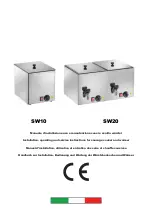
general hints
and tips
Hints general
• Preheat oven until oven indicator light cycles off, approximately
30 minutes unless stated in a specific recipe
• The material and finish of baking trays and dishes used
will affect the foods baked, especially base browning.
• Enamelware, anodised aluminium, darkbake ware or
non-stick interiors and coloured exteriors will assist in
maintaining or reducing the baking time and increase
base browning.
• Whereas, ovenproof glassware or ceramics are poor
conductors of heat. The shiny surface of aluminium or
polished steel utensils or trays also reflects the heat rather
then passing it through to the food being baked.
• Always place dishes centrally on the shelf to ensure
even browning.
• Stand casseroles dishes or similar-type dishes on suitably
sized baking trays to prevent spillage onto the base of
oven to make cleaning of oven easier.
• Do not place dishes, trays or baking pans directly on the
oven base as it becomes very hot and will crack and
craze the oven liner.
• Use ovenproof cookware, which will withstand
temperatures of 250°C.
• DO NOT use baking trays larger than 30 x 35cm (12 x
14 inches) as they will restrict the circulation of the heat
and may affect performance of the oven.
• Use shallow casserole dishes in preference to deeper ones,
this shortens cooking time in the oven.
Conventional oven
• Single shelf baking gives better results. However,
shelf position is critical, the centre of the oven is the
temperature shown on the oven control knob.
• DO NOT place baking trays, oven dishes or foil directly
on the base of oven, as trapped heat will crack and
craze the floor of the oven liner.
Fan Forced
• Baking trays, oven dishes SHOULD NOT be placed directly
against the grid covering the fan at the back of the oven.
• Do Not Place oven dishes directly on the oven base.
• Make sure shelves are evenly spaced.
• When baking more than one dish in fan forced oven,
place dishes centrally on shelves rather than several
dishes on one shelf.
• When the oven is full you may need to allow a slightly
longer baking time.
• When different sizes or trays or types of food are baked
they will not necessarily be ready together.
general tips
Condensation and Steam
• Always stand back from heated oven when opening oven
door to allow any build-up of steam or heat to release
• During baking/cooking steam may be produced which
can be released when opening the oven door. This is
quite normal.
• If there is any build-up of condensation on oven door it
is recommended that it be carefully wiped away either
during or after baking/cooking.
Cleaning
Ovens and hobs are made from steel and enamel. Enamel
is essentially glass fired onto a base of steel, therefore, if
abrasives and harsh scourers are used it may scratch the surface.
General
• Always clean appliance after use, especially food
spillage. Do not use steel wool, wax polishes, non caustic
or caustic based commercial cleaners as these will
damage your oven.
• Do not use steam cleaners, as this may cause moisture
build-up
especially in the glass door
.
• Door Glass – do not use harsh abrasive cleaners or sharp
metal scrapers to clean glass since they can scratch the
surface, which may result in shattering of the glass.
NOTE: Door glass is a tough and durable material designed
to withstand heating and cooling without breaking. However
it must be remembered that it is glass and may break, treat
the glass with care. If you have any questions about the glass
in the oven please contact the Service centre on 13 13 49.
10 GENERAL HINTS AND TIPS Chef 540 Upright Cooker










































